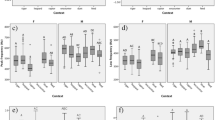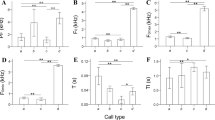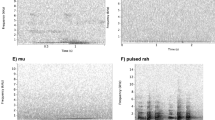Abstract
Vocal sounds of 15 individuals ofCrocidura leucodon (Hermann, 1780) emitted during agonistic and amicable interactions in male-male, female-female and male-female dyadic encounters, and intraspecific cage groups, were studied. An analysis of spectral properties, along with an examination of context and function, were performed. The sounds registered during agonistic interactions showed an increase, then a decrease in frequency, often followed a complex undulating curve. The dominant frequency (DF) was 10.7±0.05 kHz, and duration (DU) was 104.2±4.4 ms. The calls emitted by shrews at investigation and grooming often ended with chirping notes (DF=4.8±0.2 kHz, DU=23.5±1.1 ms). While clustering and huddling up to the partner, the animals produced calls consisting of short notes with a very low intensity (DF=1.0±0.07 kHz, DU=35.2±0.8 ms). Based on these finding, it can be assumed that threatening sounds, emitted in agonistic encounters, allow shrews to avoid conflicts, while those, emitted when clustering and huddling up to the partner, contribute to maintenance of group cohesiveness. The variability of frequency ranges and intensity of sounds probably reflects the territorial and gregarious behaviour ofC. leucodon and adaptation to communication in variable acoustic environments.
Similar content being viewed by others
References
Branis M. and Burda H. 1994. Visual and hearing biology of shrews. [In: Advances in the biology of shrews. J. F. Merritt, G. L. Kirkland Jr and R. K. Rose, eds]. Special Publication of Carnegie Museum of Natural History 18, Pittsburgh, Pennsylvania: 189–200.
Buchler E. R. 1976. Experimental demonstration of echolocation by the wandering shrew (Sorex vagrans). Animal Behaviour 24: 858–873.
Burda H. and Bauerova Z. 1985. Hearing adaptation and feeding ecology inSorex araneus andCrocidura suaveolens (Soricidae). Acta Zoologica Fennica 137: 253–254.
Cantoni D. and Vogel P. 1989. Social organization and mating system of free-ranging, greater white-toothed shrews,Crocidura russula. Animal Behaviour 38: 205–214.
Churchfield S. 1990. The natural history of shrews. Christopher Helm, London: 1–178.
Credner S., Burda H. and Ludescher F. 1997. Acoustic communication underground: Vocalization characteristics in subterranean social mole-rats (Cryptomys sp., Bathyergidae). Journal of Comparative Physiology A 180: 245–255.
Crowcroft P. 1957. The life of the shrew. Max Reinhardt, London: 1–166.
Forsman K. A. and Malmquist M. G. 1988. Evidence for echolocation in the common shrew,Sorex araneus. Journal of Zoology, London 216: 655–663.
Fowler J., Cohen L. and Jarvis P. 1998. Practical statistics for field biology. John Wiley & Sons, Chichester: 1–91.
Frank F. 1984. Zur Arealverschiebung zwischenCrocidura russula undC. leucodon in NW Deutschland und zum wechselseitigen Verhältnis beider Arten. Zeitschrift für Säugetierkunde 49: 65–70.
Gould E. N. 1969. Communication in three genera of shrews (Soricidae):Suncus, Blarina andCryptotis. Communications in Behavioral Biology, part A, 3: 11–31.
Gould E. 1983. Mechanisms of mammalian auditory communication. [In: Advances in the study of mammalian behavior. J. F. Eisenberg and D. G. Kleiman, eds]. Special Publication of American Society of Mammalogists no 7: 265–342.
Gould E., Negus N. and Novick A. 1964. Evidence for echolocation in shrews. Journal of Experimental Zoology 156: 19–38.
Herter K. 1957. Das Verhalten der Insectivoren. Handbuch der Zoologie 10: 1–50.
Hutterer R. and Vogel P. 1977. Abwehrlaue afrikanischer Spitzmäuse der GattungCrocidura Wagler, 1832 und ihre systematische Bedeutung. Bonner Zoologische Beitraege 28: 218–227.
Hutterer R., Vogel P., Frey H. and Genoud M. 1979. Vocalization of the shrewsSuncus etruscus andCrocidura russula during normothermia and torpor. Acta Theriologica 24: 267–271.
Lehner P. (ed) 1996. Handbook of ethological methods. Cambridge University Press, Cambridge: 1–672.
Konstantinov A. I. 1978. Functional adaptations of the mammalian auditory system. [In: Abstracts of papers presented during the 2nd Congressus Theriologicus Internationalis, Brno, Czechoslovakia. R. Obrtel, C. Folk and J. Pellantova, eds]. Institute of Vertebrate Zoology, Brno: 319.
Konstantinov A. I. and Movchan V. N. 1985. [Acoustical bonds in different groups of mammals. Nocturnal inhabitations of forest. Hedgehogs. Shrews]. [In: Zvuki v zhizni zverei. A. Malchevskii, ed]. Izdatelstvo Leningradskogo Universiteta, St. Petersburg: 56–81. [In Russian]
Movchan V. N. and Shibkov A. A. 1982. Structural patterns of acoustic signals in shrews (Soricidae). Zoologicheskii Zhurnal 61: 1695–1705. [In Russian with English summary]
Nevo E., Heth G., Beiles A. and Frankenberg E. 1987. Geographic dialects in blind mole rats: role of vocal communication in active speciation. Proceedings of the National Academy of Sciences of the United States of America 84: 3312–3315.
Rado R., Wollberg Z. and Terkel J. 1991. The ontogeny of seismic communication during dispersal in the blind mole rat. Animal Behaviour 42: 15–21.
Rudran R. and Kunz T. 1996. Appendix 1: Ethics in research. [In: Measuring and monitoring biological diversity. Standard methods for mammals. D. E. Wilson, F. R. Cole, J. D. Nichols, R. Rudran and M. S. Foster, eds]. Smithsonian Institution Press, Washington and London: 251–254.
Rychlik L. 1998. Evolution of social systems in shrews. [In: Evolution of shrews. J. M. Wójcik and M. Wolsan, eds]. Mammal Research Institute, Polish Academy of Sciences, Białowieża: 347–406.
Shchipanov N. A. and Oleinichenko V. Yu. 1993. [The bicoloured white-toothed shrew. Behaviour, spatial-ethological and functional structure of populations]. Nauka, Moscow: 1–131. [In Russian]
Shibkov A. A., Movchan V. N. and Sobolevskii S. A. 2001. Acoustic signaling of the water shrew,Neomys fodiens (Insectivora, Soricidae), in conflict interruptions. Zoologicheskii Zhurnal 80: 452–458. [In Russian with English summary]
Tomasi T. E. 1979. Echolocation by the short-tailed shrewBlarina brevicauda. Journal of Mammalogy 60: 751–759.
Vogel P. and Genoud M. 1981. The construction and use of an artificial nest to study the wild shrewCrocidura russula (Mammalia, Soricidae) in its natural environment. Journal of Zoology, London 195: 549–553.
Author information
Authors and Affiliations
Additional information
Associate Editor was Leszek Rychlik.
Rights and permissions
About this article
Cite this article
Simeonovska-Nikolova, D.M. Vocal communication in the bicoloured white-toothed shrewCrocidura leucodon . Acta Theriol 49, 157–165 (2004). https://doi.org/10.1007/BF03192517
Received:
Accepted:
Issue Date:
DOI: https://doi.org/10.1007/BF03192517




